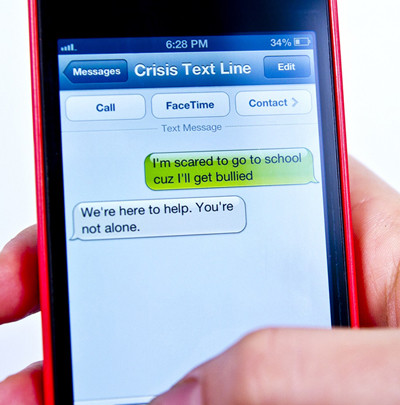In 2011, Nancy Lublin, founder of Crisis Text Line, had an idea that would fill a hole in crisis mental health services. At the time, old-school providers dominated the service market but operated primarily via call centers, which had limited hours and limited reach. As a result, many of the 65 million Americans who suffer from mental illness each year—including depression, anxiety, eating disorders, and suicidal thoughts—didn’t have access to resources and support when and where they needed it. Lublin’s solution: Build a highly scalable platform to reach people in crisis, 24/7, via a medium people already use and trust—texting. At the time, most crisis mental health support organizations—mired in the day-to-day of providing crisis telephone service—operated with restricted funding and lacked a profit motivation to add texting service. These conditions made innovation tough.
It was a great idea, and Lublin was an experienced entrepreneur with two successful ventures under her belt, but funders were slow to buy the relevance and value of an untested service that broke the mold. Lublin says: “There is a lot of talk about innovation in the social sector but very little capital to support it. There are tiny grants that are highly restricted, but early-stage companies are unpredictable. They need a commitment of significant funding to prove there is a there there.”

Indeed, traditional early-stage funding is often small and incremental. Undercapitalized start-ups are left to demonstrate the effectiveness of their game-changing ideas with capital that allows them only to cobble together a skeleton of what the idea could be.
Taking a For-Profit Tech Startup Approach to Nonprofit Fundraising
 Crisis Text Line’s live, trained crisis counselors receive texts
Crisis Text Line’s live, trained crisis counselors receive texts from people who need help and respond quickly.
From the start, Crisis Text Line was equal parts social mission and tech company. It needed to hire people who could build a technology platform that would accommodate huge numbers of users, and collect and make sense of vast amounts of data.
Traditional nonprofit fundraising often requires a traditional business plan and a slow raise of dollars over several years—a funding model that forces organizations to hire piecemeal and underinvest in systems. Meanwhile, Lublin was watching other for-profit technology companies go out and raise start-up capital in funding rounds. In early 2015, she lined up a series of tightly coordinated conversations that took place over a week, and hit the road to raise her first round of funding. By the end of the week, she had her “angel” round of philanthropic capital, $5 million, mostly from tech entrepreneurs. This was enough to invest in, among other things, a technology team to build the platform and a data scientist to make sense of the vast amounts of data they were collecting.
Within months, solely by word of mouth, the platform began exploding with texts from people all over the country, in both rural and urban areas. Originally, the organization contracted with traditional hotlines to provide services, but when they proved unable to keep up with demand, Crisis Text Line shifted to a new model of recruiting and training its own volunteer crisis counselors. This involved creating a top-notch, online training program for volunteers and modifying the technology for use by thousands of volunteers accessing the platform from their homes. Iterations on the technology and training happened weekly, allowing the organization to ramp up recruitment and training from 200 volunteers to 3,000 in just two years. Demand grew organically: A single Facebook post by someone with something positive to say about Crisis Text Line regularly caused many others to reach out. The unrestricted seed round of financing gave the organization the room it needed to iterate quickly, again and again, to meet demand. Without it, long wait times or failure of the platform could have tanked demand for good.
By this time, it was clear Crisis Text Line was onto something big, and the funding needed to keep pace with its growth. In early 2016, the organization raised a second round of philanthropic funding—this time more than $20 million—and, like the early capital raised by Twitter and every other successful for-profit tech venture, it was unrestricted. The organization wasn’t tied to hitting specific metrics required by funders, but could use the capital to build, grow, and iterate.
Putting Dollars Toward Data
Significant early funding helped Crisis Text Line respond to 52 million texts over four years. It also fueled an important organization tool: data. Lublin says: “We like to say Crisis Text Line is mobile only and data first. We launched knowing the data was going to be a huge part of what we do. So from the beginning, we thought about how to collect, store, and analyze every possible piece of information to make us smarter and faster and more accurate.”
Our chief data scientist describes us as an “.org-anism.” An organism or person thrives to the degree that she experiences pain and learns from it. When a person touches a hot stove, for example, her hand sends a signal of pain to her brain, she moves away her hand, and she avoids further damage. The same general principle applies to organizations; to borrow from hedge fund manager Ray Dalio, "pain + reflection = progress.” Just like a person, Crisis Text Line thrives to the degree we quickly and consistently spot pain, and correct our actions accordingly.
While traditional funding mechanisms tie start-up organizations to metrics that funders either design and/or must approve, unrestricted funding helps organizations invest in collecting and learning from data, and iterating their product in real time.
In addition, given Crisis Text Line’s 70 staff and 3,700 volunteers, data is the only way to humanize, because it’s the only way for the organization to know the experience of all people in the organization in real time, and to quickly respond and adjust accordingly. For instance, data showed that when crisis counselors alerted local police or emergency services to people in imminent danger of harm, they experienced real anxiety not knowing when emergency services were on their way and when they made contact with the person in crisis. Crisis Text Line created a new feature that allowed them to see what was taking place in real time.
Lublin says, “Whenever we encounter a challenge, we think: product, policy, people. In that order. Most established organizations don’t have the ability to change their product.” She knew from experience that she needed the funding leeway to iterate constantly. Her organization learns by doing. This is its strength, and it was built on bold philanthropic support for a bold idea. “Our advice for funders?” she says, “It’s not a spectator sport. Come in early and stay late. The world’s problems demand it”.
Support SSIR’s coverage of cross-sector solutions to global challenges.
Help us further the reach of innovative ideas. Donate today.
Read more stories by Stephanie Dodson.

